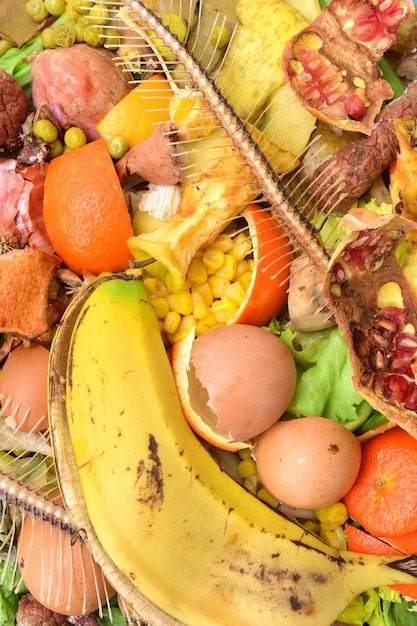Shocking Food Waste: Americans Toss 150,000 Tons Daily!

Amazing Fact: Americans Throw Away Approximately 150,000 Tons of Food Each Day, a staggering amount that highlights significant issues with food production, distribution, and consumption habits in the United States, ultimately impacting the environment, economy, and food security.
It’s an amazing fact: Americans throw away approximately 150,000 tons of food each day. This shocking statistic unveils a deep-seated problem that extends far beyond just individual households, impacting our environment, economy, and overall food security.
The Staggering Scale of American Food Waste
The numbers are truly astounding when we look at the scale of food waste in the United States. It’s not simply a matter of a few forgotten leftovers; it’s a systemic issue contributing to a multitude of problems.
How Much Food is Really Wasted?
Studies and reports from organizations like the EPA and USDA reveal that roughly 30-40% of the entire US food supply is wasted. This waste occurs at every stage, from farm to fork, in our homes, grocery stores, restaurants, and processing facilities.
Consider the implications of that percentage. Imagine nearly half of all the food produced never gets eaten. It sits rotting in landfills, emitting methane gas, a potent greenhouse gas. It represents a massive waste of resources – water, land, energy, and labor – that went into producing that uneaten food.
Where Does All This Waste Come From?
Understanding where food waste originates is crucial for developing effective solutions. It’s not solely a consumer issue; the problem is multifaceted.
- Agricultural Production: Crop spoilage due to pests, diseases, and weather events contribute substantially. Overproduction in response to fluctuating market demands also leads to waste.
- Processing and Packaging: Damage during processing, inefficient packaging, and trimming losses all add to the total.
- Retail: Grocery stores often overstock to offer variety, leading to unsold produce and packaged goods. Cosmetic standards also result in perfectly edible items being discarded for superficial imperfections.
- Consumer Behavior: Poor meal planning, misunderstanding expiration dates, improper storage, and simply not eating leftovers are significant contributors at the household level.
Addressing food waste demands a comprehensive approach involving stakeholders at every level of the food system.

In conclusion, the scale of food waste in the United States is immense, and understanding its origins across the food supply chain is essential for finding effective solutions.
The Environmental Impact of Food Waste
Beyond the initial shock of the quantity, understanding the environmental implications of food waste paints an even grimmer picture. The consequences go far beyond just wasted resources.
Greenhouse Gas Emissions
When food rots in landfills, it produces methane, a greenhouse gas significantly more potent than carbon dioxide. Food waste is a major contributor to global greenhouse gas emissions, exacerbating climate change.
In fact, if food waste were a country, it would be the third-largest emitter of greenhouse gases globally, after China and the United States. This highlights the profound impact of our collective food waste habits on the planet.
Wasted Resources
Producing food requires vast amounts of resources, from water and land to energy and fertilizers. When food is wasted, so are all the resources used to produce it.
Consider the water footprint of food waste. Agriculture is a major water consumer, and wasting food means wasting precious water resources. Similarly, land used for agriculture, often cleared from natural habitats, is wasted when the food grown on it ends up in landfills.
Pollution and Ecosystem Degradation
The production and transportation of food often involve the use of pesticides, fertilizers, and fossil fuels, all of which contribute to pollution and ecosystem degradation. When food is wasted, these environmental impacts are amplified.
Furthermore, the disposal of food waste in landfills can lead to soil and water contamination, further harming ecosystems and human health.
Therefore, reducing food waste is not just about saving money; it’s about protecting our planet and ensuring a sustainable future.
Economic Consequences of Food Waste
Beyond the environmental impact, food waste has significant economic consequences, affecting consumers, businesses, and the economy as a whole.
Financial Losses for Households
The average household throws away a significant portion of the food they purchase each year. This translates to substantial financial losses, as money spent on food that is never eaten is essentially thrown away.
Estimates suggest that families could save hundreds or even thousands of dollars each year by reducing their food waste. This money could be used for other necessities or investments, improving household financial stability.
Business Losses and Inefficiencies
Businesses throughout the food supply chain, from farms to restaurants, also suffer financial losses due to food waste. Spoilage, overstocking, and inefficient processes contribute to these losses.
Restaurants, for example, often throw away large amounts of food at the end of each day. Grocery stores discard produce that doesn’t meet cosmetic standards. These losses impact profitability and can lead to higher prices for consumers.
Impact on Food Prices
Food waste contributes to higher food prices, as businesses attempt to recoup losses from wasted food. This disproportionately affects low-income households, who spend a larger percentage of their income on food.
Reducing food waste can help to stabilize food prices, making food more accessible and affordable for everyone.

In short, the economic consequences of food waste are far-reaching, impacting households, businesses, and the overall economy. Reducing food waste is not only environmentally responsible but also economically beneficial.
Practical Strategies for Reducing Food Waste at Home
While the problem of food waste may seem overwhelming, there are many practical steps individuals can take to reduce waste at home and make a difference.
Plan Your Meals
One of the most effective ways to reduce food waste is to plan your meals in advance. This helps you buy only what you need and avoid impulse purchases that often end up going to waste.
Take some time each week to plan your meals, considering what you already have on hand and what ingredients you need to buy. Create a shopping list and stick to it when you go to the grocery store.
Proper Food Storage
Proper food storage is essential for extending the shelf life of your food and preventing spoilage. Store fruits and vegetables properly to maintain freshness.
Use airtight containers to store leftovers and cut produce. Pay attention to expiration dates and use older items first. Rotate your stock in the refrigerator and pantry to ensure that you are using items before they expire.
Understand “Use By” and “Best By” Dates
Many people misunderstand “use by” and “best by” dates, often throwing away food that is still perfectly safe to eat. “Use by” dates indicate when a product should be consumed for quality reasons. “Best by” dates indicate when a product is at its peak quality, but it is often still safe to eat after that date.
Learn to differentiate between these dates and use your senses to determine whether food is still safe to eat. If a product looks, smells, and tastes fine, it is likely still safe to consume, even if it is past its “best by” date.
Embrace Leftovers
Leftovers are a fantastic way to reduce food waste and save time on meal preparation. Don’t let leftovers languish in the refrigerator; incorporate them into new meals or eat them for lunch.
- Transform leftover roasted chicken into chicken salad or tacos.
- Use leftover vegetables in soups or stir-fries.
- Freeze leftovers for future meals.
By embracing leftovers, you can reduce waste and enjoy delicious, home-cooked meals.
In conclusion, reducing food waste at home is a simple and effective way to save money, protect the environment, and promote a more sustainable food system.
The Role of Technology in Combating Food Waste
Innovative technologies are emerging to help combat food waste at every stage of the supply chain, from farms to households.
Smart Packaging
Smart packaging technologies can extend the shelf life of food and provide real-time information about its freshness. These technologies include modified atmosphere packaging, which controls the gas composition inside the package to slow down spoilage, and sensors that monitor temperature, humidity, and other factors that affect food quality.
Smart packaging can help reduce waste by keeping food fresher for longer and providing consumers with information about when it is still safe to eat.
Data Analytics and Supply Chain Optimization
Data analytics can be used to optimize the food supply chain, reducing waste at every stage. By analyzing data on production, distribution, and consumption, businesses can identify inefficiencies and implement strategies to reduce waste.
For example, data analytics can be used to optimize inventory management, reducing overstocking and spoilage in grocery stores. Farmers can use data to predict crop yields and adjust planting schedules to minimize waste from overproduction.
Apps and Platforms for Connecting Surplus Food with Consumers
Several apps and platforms are emerging to connect businesses with surplus food with consumers who are willing to purchase it at a discount. These platforms help to prevent edible food from going to waste and provide affordable meals to consumers.
- Too Good To Go: This app connects consumers with restaurants and grocery stores that have surplus food to sell at a discount.
- Olio: This app allows neighbors to share surplus food with each other, preventing it from going to waste.
- Food Rescue US: This organization uses technology to connect volunteers with businesses that have surplus food, which is then donated to local charities.
These digital tools are helping to create a more efficient and sustainable food system.
In summary, technology plays a crucial role in combating food waste by extending shelf life, optimizing supply chains, and connecting surplus food with consumers.
Policy Initiatives and Community Programs Addressing Food Waste
Governments and communities are implementing policies and programs to tackle food waste at a larger scale.
Government Regulations and Incentives
Several countries and regions have implemented regulations to reduce food waste, such as bans on sending food waste to landfills and tax incentives for businesses that donate surplus food. These policies encourage businesses and individuals to reduce waste and divert it to beneficial uses.
For example, some states have implemented “food donation liability protection” laws, which protect businesses from liability when they donate surplus food to charities. This encourages businesses to donate food that would otherwise go to waste.
Food Recovery Programs
Food recovery programs collect surplus food from businesses and redistribute it to people in need. These programs help to reduce waste and address food insecurity at the same time.
Organizations like Feeding America operate a network of food banks that collect and distribute surplus food to communities across the country. These food banks rely on donations from businesses and individuals to provide food to people facing hunger.
Community Composting Initiatives
Community composting initiatives provide residents with a place to compost their food scraps and yard waste, diverting it from landfills. These initiatives often involve community gardens and educational programs to teach people about composting.
By composting food waste, communities can create valuable soil amendments and reduce greenhouse gas emissions from landfills.
In conclusion, policy initiatives and community programs play a crucial role in addressing food waste at a systemic level, promoting a more sustainable food system.
| Key Point | Brief Description |
|---|---|
| 🗑️ Amount of Food Waste | Americans waste approximately 150,000 tons of food daily. |
| 🌍 Environmental Impact | Food waste contributes significantly to greenhouse gas emissions and resource depletion. |
| 💰 Economic Impact | Food waste results in financial losses for households and businesses. |
| 💡 Solutions | Strategies include meal planning, proper storage, and technology solutions. |
Frequently Asked Questions (FAQ)
▼
Several factors contribute, including overbuying, misunderstanding expiration dates, improper storage, and a culture of abundance. Cosmetic standards in retail also lead to the discarding of edible, yet imperfect, produce.
▼
Food waste rotting in landfills produces methane, a potent greenhouse gas. It also wastes the resources used in food production, such as water, land, and energy, contributing to pollution and ecosystem degradation.
▼
Meal planning, proper food storage, understanding “use by” dates, embracing leftovers, and composting are effective strategies. Buying only what you need and using what you buy can significantly reduce waste.
▼
Smart packaging extends shelf life, data analytics optimize supply chains, and apps connect surplus food with consumers, all contributing to waste reduction. Technology enhances efficiency and awareness about food waste issues.
▼
Government regulations, food recovery programs, and community composting initiatives reduce waste and divert it to beneficial uses. These initiatives encourage collective action and promote a more sustainable food system overall.
Conclusion
The **amazing fact** that Americans throw away approximately 150,000 tons of food each day is a stark reminder of the urgent need to address food waste. By understanding the environmental and economic consequences, adopting practical strategies, and supporting policy initiatives, we can collectively move towards a more sustainable and equitable food system. Every effort, no matter how small, contributes to a significant positive impact.





